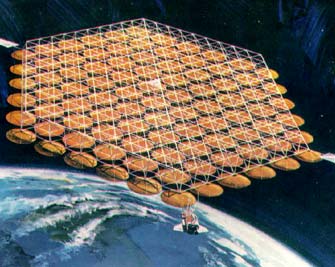Space Solar Energy

The failures of the nuclear reactors in Japan to safely shut down during the 9.0 earthquake demonstrate the dangers posed by nuclear energy.
The radiation from melting reactor cores and the smoke of burning spent fuel rods point to the generation of an inexhaustible, safe, pollution-free supply of energy from outer space.
Interestingly, Japan is the only nation that has a dedicated space solar energy program and is probably now more motivated to change directions than ever before.
Space-solar energy could, potentially, solve the world's energy and greenhouse gas emission problems.
The technology currently exists to launch solar-collector satellites into geostationary orbits around the Earth to convert the Sun's radiant energy into electricity 24 hours a day and to safely transmit the electricity by microwave beams to rectifying antennas on Earth.
With increases in electricity demand and costs, NASA took a look at the concept between 1995 and 1997. The NASA study envisioned a trillion-dollar project to place several dozen solar-power satellites in geostationary orbits by 2050, sending between two gigawatts and five gigawatts of power to Earth.
There are three basic engineering problems presented in the deployment of a space-based solar power system: the size, weight and capacity of solar collectors to absorb energy; the ability of robots to assemble solar collectors in outer space; and the cost and reliability of lifting collectors and robots into space.
Two of these problems have been substantially solved since space-solar power was originally proposed. New thin-film advances in the design of solar collectors have steadily improved, allowing for increases in the efficiency of energy conversion and decreases in size and weight. At the same time, industrial robots have been greatly improved and are now used extensively in heavy manufacturing to perform complex tasks.
The remaining problem is the expense of lifting equipment and materials into space. The last few flights of the space shuttle this year will cost $20,000 per kilogram of payload to move satellites into orbit and resupply the space station.
It has been estimated that economic viability of space solar energy would require a reduction in the payload cost to less than $200 per kilogram and the total expense, including delivery and assembly in orbit, to less than $3,500 per kilogram.
Although there are substantial costs associated with the development of space-solar power, it makes far more sense to invest precious public resources in the development of an efficient and reliable power supply for the future, rather than to waste U.S. tax dollars on an ineffective missile defense system, an ego trip to Mars, or $36 billion in risky loan guarantees by the DOE to the nuclear power industry.
Over the past two years, Japan has committed $21 billion to secure space-solar energy. By 2030, the Japan Aerospace Exploration Agency plans to "put into geostationary orbit a solar-power generator that will transmit one gigawatt of energy to Earth, equivalent to the output of a large nuclear power plant." Japanese officials estimate that, ultimately, they will be able to deliver electricity at a cost of $0.09 per kilowatt-hour, which will be competitive with all other sources.
http://www.thepeoplesvoice.org/TPV3/Voices.php/2011/03/26/the-race-for-space-solar-energy
